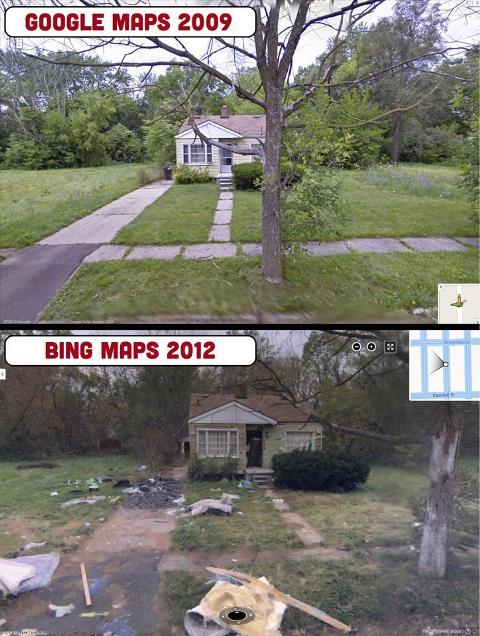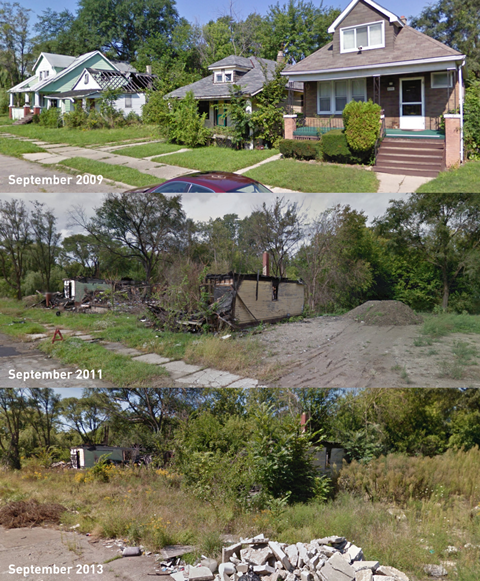A New Decline
The financial crisis of 2008 ignited a period of population loss and deterioration of property unmatched in Detroit’s history, even compared to the era including the 1967 riots. Some of the most poignant documentary evidence of this collapse of an impoverished city was captured thanks to one of the most valuable companies on earth.
In August of 2007, as the financial crisis metastasized, Google Street View arrived in Detroit and began collecting imagery of every property and every street in the city. The Street View cars would return every two years between 2007 and 2015. Each time, Street View added a new, comprehensive frame to its incidental documentation of Detroit’s post-financial crisis collapse.
In 2012, in an offshoot of my work with the Detroit-based property mapping software & data company, Loveland Technologies, I began taking screenshots of Detroit property on Google Street View and Bing Streetside (Microsoft’s competitor to the Street View service) after realizing the two companies had passed through Detroit about two years apart (Google in 2009, Microsoft 2011). I recorded this comparison “photography” on a blog called GooBing Detroit—a portmanteau of Google and Bing.
At Loveland at that time, we spent countless days poring over foreclosure data in the city, building maps and datasets to try to understand the annual crashing waves of foreclosures. I arrived in Detroit from Brooklyn in 2011, so I only knew what foreclosure properties looked like in present day. I wanted to know how recently their deterioration had started. The screenshots I started capturing via Google and Bing revealed properties that had been occupied homes in good condition in 2009 and, by 2011, were clearly abandoned, half-burnt, or rubble. Examples were not hard to find.
| figure 1 |
 |
| screenshots via Google and Bing of an occupied home (top) in 2009 and the same home abandoned (bottom) in 2011 |
A group in Detroit that provides legal support for residents who face foreclosure, Detroit Eviction Defense, has an evocative and apt name for the post-financial crisis fallout in Detroit: A Hurricane Without Water.
In Context
Between 1970 and 1980, when population loss was most severe after the riots, Detroit lost 20 percent of its people, falling from 1.5 million residents in 1970 to 1.2 million in 1980. Between 2004 and 2014, the most recent ten-year span with available data that includes the financial crisis, Detroit’s population fell from 925,000 to 680,000, a 26 percent decline.
Expanding the comparison period to 1960 – 1980, Detroit’s population fell from 1.67 million to 1.2 million -- a 28 percent decline. Post-financial crisis Detroit has lost nearly as large a percentage of its population as pre- and post-riot Detroit, in half as much time.
Today, as people leave, property disintegrates. Between 2008 and 2015, more than 125,000 of Detroit’s 385,000 properties were foreclosed for failure to pay property taxes. Of those 125,000 foreclosures, 66,000 failed to sell at tax foreclosure auctions for just $500 a piece—the minimum offering for all properties in the final auction round. Measured another way, foreclosure auctions over the last eight years have offered, conservatively, ten square miles of Detroit for sale for a total cost of $33 million, or, a rate of a little more than one cent per square foot of land—2.5 billion square feet of land.
The storm continues in 2016—52,000 Detroit properties faced foreclosure entering this year, 33,000 of them occupied homes representing around 100,000 Detroiters facing foreclosure.
The Archaeology of Collapse
In 2014, Google released an upgrade to Street View, called Google Street View Time Machine. The feature allows you to see Street View imagery for every year Google has driven a city. Previously, Street View offered only the most recent year’s imagery, hence the need to combine Google and Bing to see change over time.
In Detroit, imagery is generally available for 2009, 2011, 2013, and parts of the city in 2015. In my work taking screenshots of Detroit’s post-financial crisis decline, I abandoned Bing and stuck exclusively to Google’s Street View Time Machine, expanding the number of frames per property and providing more resolution to the narrative of decline.
| figure 2 |
 |
| Google Street View Time Machine Imagery of a block in Detroit from 2009 - 2013 |
Almost immediately after I transitioned to using Google Street View Time Machine imagery, GooBing went viral. Detroit’s bankruptcy was ongoing and media attention on the city was high. GooBing appeared in newspapers in Japan, Germany, Hungary, France, Estonia, the Daily Mail in London and on websites ranging from the Verge to Zero Hedge, the fatalistic economics blog with a fanatic financier following where it was one of the top ten stories of 2014. On Yahoo.com, GooBing landed on the front page where the article’s writer reported 2 million readers had flipped through images from the blog 70 million times.
In Detroit’s bankruptcy trial, images from GooBing were presented to Dan Gilbert, founder of Quicken Loans and chair of the federally appointed Detroit Blight Task Force, during his testimony as evidence of the present condition of the city.
I was, apparently, not alone in my surprise as a transplant from Brooklyn with no prior experience of Detroit that the city’s decline had not been the steady downward slope starting in the 1960s I’d imagined. The financial crisis had delivered a crushing new blow to an already-down city.
The Cause of the Hurricane
People want Detroit to be an illuminating detail for the rest of the country—either as the canary in the coalmine or a shining beacon of recovery and renewal. The reality, as it seems to insist on being, is more complicated.
When the financial crisis struck Detroit, it aggravated a set of conditions unique to Detroit and uniquely suited to result in calamity induced by a collapse in the housing market:
As the opening years of the financial crisis eroded what jobs were left, Detroiters turned home to face the highest property tax burden in the country. Over-assessed properties and a cash-strapped city amounted to the wringing of blood from a stone. In response, hundreds of thousands of Detroiters, unable or unwilling, stopped paying property taxes. Today, only 35 percent of Detroit’s 385,000 properties generate regular property tax revenue.
Delinquent property taxes put Michigan’s brutally efficient tax foreclosure law to work. Designed to foreclose on properties quickly and return them to productive use through foreclosure auctions, the law instead presided over tens of thousands of Detroiters abandoning, or being evicted from, their overtaxed and undervalued homes.
The foreclosure auctions, instead of an avenue to reuse via the market, discovered the market saw no value in Detroit property. What little value was seen came in the form of rampant speculation and property fraud, which only perpetuated further evictions and abandonment.
As for the properties themselves, nearly 50,000 vacant across Detroit, many publicly owned by a city unable to care for them, some waiting for tax foreclosure to deliver that fate, they were beset by metal scrappers, arsonists, and weather. In Detroit, 65 percent of all homes are detached, single family structures, many hastily built to accommodate the workforce of the mid-twentieth century. No form of housing was at greater risk for the forces Detroit has encountered since the crisis, and the resulting physical state of those properties makes the hurricane comparison apt.
Parts of this story are unique to Detroit—no city shares the concentration of old, large, single family homes that Detroit does, and no form of housing was at greater risk for the storm that struck the city and hovers stubbornly over it still today. Parts of the story are unique to Michigan—no state shares a tax foreclosure law as punishing and draconian as Michigan’s.
Yes, post-industrialism, racism and corruption apply locally and nationally, but the particular causes of Detroit’s post-financial crisis experience are unique to the city and the moment. The city faces an underlying disease whose most virulent symptom at this moment is tax foreclosure, and it’s a symptom that can kill its host.
Despite the wealth of data and human stories available to convey Detroit’s contemporary story, it is the unexpected significance of Google Street View that has perhaps captured most powerfully the impact and evidence of the financial crisis on Detroit. The decline continues, its evidence will be captured by the dispassionate cameras atop the Street View cars for history to rewind and re-watch.
This piece is an extended version of the artist’s statement that accompanied the exhibit “A Hurricane Without Water,” a showcase of the Street View photography discussed above, at Austin’s Prizer Gallery.
|


